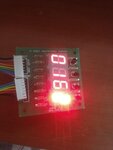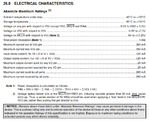venkates2218
Full Member level 6

Code:
#include "xc.h"
#define XTAL_FREQ 20MHZ /* Crystal frequency in MHz */
#include "delay.h"
#include "eeprom.h"
// CONFIG1H
#pragma config OSC = HS // Oscillator Selection bits (HS oscillator)
#pragma config FCMEN = OFF // Fail-Safe Clock Monitor Enable bit (Fail-Safe Clock Monitor disabled)
#pragma config IESO = OFF // Internal/External Oscillator Switchover bit (Oscillator Switchover mode disabled)
// CONFIG2L
#pragma config PWRT = ON // Power-up Timer Enable bit (PWRT disabled)
#pragma config BOREN = OFF // Brown-out Reset Enable bits (Brown-out Reset disabled in hardware and software)
#pragma config BORV = 3 // Brown Out Reset Voltage bits (Minimum setting)
// CONFIG2H
#pragma config WDT = OFF // Watchdog Timer Enable bit (WDT disabled (control is placed on the SWDTEN bit))
#pragma config WDTPS = 32768 // Watchdog Timer Postscale Select bits (1:32768)
// CONFIG3H
#pragma config CCP2MX = PORTC // CCP2 MUX bit (CCP2 input/output is multiplexed with RC1)
#pragma config PBADEN = OFF // PORTB A/D Enable bit (PORTB<4:0> pins are configured as digital I/O on Reset)
#pragma config LPT1OSC = OFF // Low-Power Timer1 Oscillator Enable bit (Timer1 configured for higher power operation)
#pragma config MCLRE = ON // MCLR Pin Enable bit (MCLR pin enabled; RE3 input pin disabled)
// CONFIG4L
#pragma config STVREN = OFF // Stack Full/Underflow Reset Enable bit (Stack full/underflow will cause Reset)
#pragma config LVP = OFF // Single-Supply ICSP Enable bit (Single-Supply ICSP disabled)
#pragma config XINST = OFF // Extended Instruction Set Enable bit (Instruction set extension and Indexed Addressing mode disabled (Legacy mode))
// CONFIG5L
#pragma config CP0 = OFF // Code Protection bit (Block 0 (000800-001FFFh) not code-protected)
#pragma config CP1 = OFF // Code Protection bit (Block 1 (002000-003FFFh) not code-protected)
#pragma config CP2 = OFF // Code Protection bit (Block 2 (004000-005FFFh) not code-protected)
#pragma config CP3 = OFF // Code Protection bit (Block 3 (006000-007FFFh) not code-protected)
// CONFIG5H
#pragma config CPB = OFF // Boot Block Code Protection bit (Boot block (000000-0007FFh) not code-protected)
#pragma config CPD = OFF // Data EEPROM Code Protection bit (Data EEPROM code-protected)
// CONFIG6L
#pragma config WRT0 = OFF // Write Protection bit (Block 0 (000800-001FFFh) not write-protected)
#pragma config WRT1 = OFF // Write Protection bit (Block 1 (002000-003FFFh) not write-protected)
#pragma config WRT2 = OFF // Write Protection bit (Block 2 (004000-005FFFh) not write-protected)
#pragma config WRT3 = OFF // Write Protection bit (Block 3 (006000-007FFFh) not write-protected)
// CONFIG6H
#pragma config WRTC = OFF // Configuration Register Write Protection bit (Configuration registers (300000-3000FFh) not write-protected)
#pragma config WRTB = OFF // Boot Block Write Protection bit (Boot block (000000-0007FFh) not write-protected)
#pragma config WRTD = OFF // Data EEPROM Write Protection bit (Data EEPROM not write-protected)
// CONFIG7L
#pragma config EBTR0 = OFF // Table Read Protection bit (Block 0 (000800-001FFFh) not protected from table reads executed in other blocks)
#pragma config EBTR1 = OFF // Table Read Protection bit (Block 1 (002000-003FFFh) not protected from table reads executed in other blocks)
#pragma config EBTR2 = OFF // Table Read Protection bit (Block 2 (004000-005FFFh) not protected from table reads executed in other blocks)
#pragma config EBTR3 = OFF // Table Read Protection bit (Block 3 (006000-007FFFh) not protected from table reads executed in other blocks)
// CONFIG7H
#pragma config EBTRB = OFF // Boot Block Table Read Protection bit (Boot block (000000-0007FFh) not protected from table reads executed in other blocks)
#define zero 0X40
#define one 0Xf9
#define two 0X24
#define three 0X30
#define four 0X19
#define five 0X12
#define six 0X02
#define seven 0XF8
#define eight 0X00
#define nine 0X10
#define segment1 PORTDbits.RD2
#define segment2 PORTDbits.RD3
#define segment3 PORTDbits.RD4
#define segment4 PORTDbits.RD5
int first_digit;
int tm1_change_timer, run_digit;
int temp1_counter, temp2_counter, temp3_counter, temp4_counter, temp5_counter, temp6_counter;
void one_display() {//1st digit
switch (first_digit) {
case 0:
PORTB = zero;
break;
case 1:
PORTB = one;
break;
case 2:
PORTB = two;
break;
case 3:
PORTB = three;
break;
case 4:
PORTB = four;
break;
case 5:
PORTB = five;
break;
case 6:
PORTB = six;
break;
case 7:
PORTB = seven;
break;
case 8:
PORTB = eight;
break;
case 9:
PORTB = nine;
break;
default:
PORTB = zero;
break;
}
}
void System_init(void) {
TRISA = 0b00000000;
PORTA = 0b00000000;
ADCON1 = 0XFF;
CMCON = 0X07;
TRISB = 0b00000000;
PORTB = 0b11111111;
TRISC = 0b00000000;
PORTC = 0b11111111;
TRISD = 0b00000000;
PORTD = 0b11111111;
TRISE = 0b00000111;
PORTE = 0b00000111;
}
/**************************************************************
Main Program
**************************************************************/
void main(void) {
System_init();
ee_init(); //EEPROM initialize
while (1) {
run_digit++;
DelayMs(100);
temp1_counter = run_digit / 1000;
temp2_counter = run_digit % 1000;
temp3_counter = temp2_counter / 100;
temp4_counter = temp2_counter % 100;
temp5_counter = temp4_counter / 10;
temp6_counter = temp4_counter % 10;
segment1 = 0;
segment2 = 1;
segment3 = 1;
segment4 = 1;
first_digit = temp1_counter;
one_display();
DelayMs(1);
segment1 = 1;
segment2 = 0;
segment3 = 1;
segment4 = 1;
first_digit = temp3_counter;
one_display();
DelayMs(1);
segment1 = 1;
segment2 = 1;
segment3 = 0;
segment4 = 1;
first_digit = temp5_counter;
one_display();
DelayMs(1);
segment1 = 1;
segment2 = 1;
segment3 = 1;
segment4 = 0;
first_digit = temp6_counter;
one_display();
DelayMs(1);
ee_write(1, 1);
ee_write(2, 2);
ee_write(3, 3);
}
}For displaying the values tried to use 7 SEGMENT display instead of LCD.When tried to display the value,first 3 digit are not showing properly it blinking...
I bought the 7 SEGMENT display from online its common anode....
Connected the display board directly to pic controller on PORTB and PORTD.
I have to store the datas in EEPROM,so I tired with simple values...
Like EEPROM operation,I have to do lot of operations,while executing the display will not show the correctly
I dono how to how to drive the display.Please help to solve this issue




